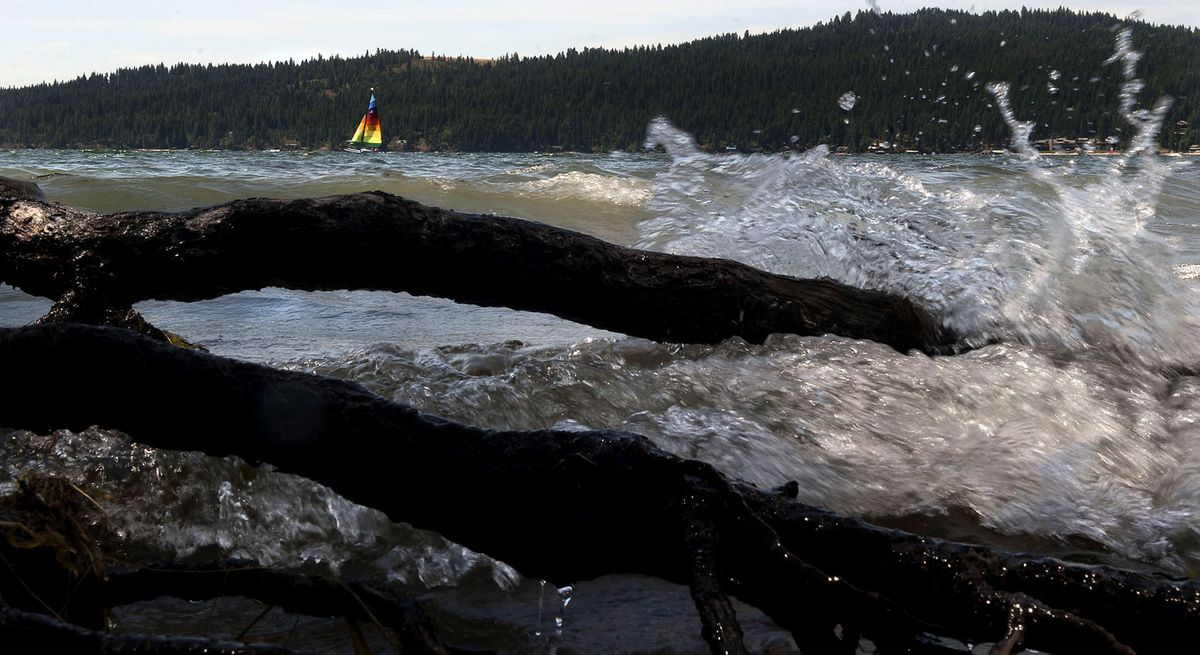Low river conditions get people talking
Historic drought takes toll on flows

The effects of a historic drought weren’t obvious at Q’emiln Park in Post Falls this week, with the Spokane River lapping at the sandy beach and kids shrieking and splashing in the swimming area.
But a few hundred yards downstream, a starker picture of river conditions emerged.
Just a trickle of water was flowing through the north channel of the Post Falls Dam on Friday afternoon. Below the dam, the Spokane River ran low and green through a narrow gorge, with higher water marks visible on the canyon’s rock walls.
The amount of water passing through the dam is 30 percent of normal for this time of year, based on a century of record-keeping. And it could soon drop farther.
Under drought provisions in the dam’s federal license, Avista Corp. will reduce the flows from the current 625 cubic feet per second to 500 cubic feet per second when Lake Coeur d’Alene drops to three inches below its maximum summer elevation, which could happen any day.
The reduced flows are part of a drought year balancing act, enacted six years ago when Avista relicensed its Spokane River dams. The goal is to keep a recreational pool in Lake Coeur d’Alene while providing water for the 112-mile long river, which flows out of the lake.
The current flow requirement is more protective than the previous standard of 300 cubic feet per second, which had been in place since the 1970s. At those flows, “you could walk across the river on rocks without getting your feet wet,” said Speed Fitzhugh, Avista’ Spokane River license manager.
But even with the higher releases, the river will be under strain this summer, and the lake could drop to record lows.
“I wish we could make water,” Fitzhugh said. “I pray for rain every night. It is the driest and warmest year we’ve seen on record.”
Normally, there’s enough water in early July to keep Lake Coeur d’Alene at full pool and provide for downstream flows. But this year – with record low snow packs and June temperatures in the 90s – has been anything but normal.
Up and down the Spokane River, people are already comparing notes about the usually low water year.
“It’s pretty crazy how far the river has dropped,” said Bryon Smith of Post Falls.
He’s been a regular at Corbin Park downstream of the Post Falls Dam over the past three months, where’s he’s built hundreds of rock cairns at the river’s edge. When he started the project – a tribute to his late stepdad – the water was flowing through the willows along the bank.
Now, he can wade across the river there.
JB Krieger likes to bring a book to Corbin Park and read by the river. “I just come down for the peacefulness,” said the retired Spokane housepainter. For six years, he’s parked his truck under the same stand of pines. He said he’s never seen the water so low.
“See that stump? The water should be about there,” he said, pointing to a spot on the bank.
Jerry White Jr., the Spokane Riverkeeper, isn’t sure how much longer the nonprofit, advocacy group can continue to use its 13-foot raft on the Spokane River.
“You start to see rocks poking up, and you think, ‘Wow, there’s very little water in the river,’” he said. “It’s more of an inter-tubing river now than a rafting and kayaking river.”
White remembers 2001, another severe drought year when only 300 cubic feet of water was released over Post Falls Dam. In parts of the Spokane Valley, “the river looked emaciated,” he said.
That was particularly true between Stateline and Barker Road, where river flows recharge the interconnected, Spokane Valley-Rathdrum Prairie Aquifer. “The river drops into the aquifer,” said Avista’s Fitzhugh.
Downstream from the Barker Road bridge, the reverse happens: Water from the aquifer begins to percolates back into the river. The aquifer water is about 49 degrees, which helps provide cold water habitat for the river’s native redband trout.
Pumping from the aquifer affects how much water is available for recharging the river. The aquifer provides drinking water for more than 500,000 of the region’s residents, and the Washington Department of Ecology estimates that supplying water for human consumption reduces river flows by 225 cubic feet per second.
Hotter, drier weather placed extra demands on the aquifer last month. The city of Spokane pumped 3.3 billion gallons of water from the aquifer in June, a 14 percent increase from the same month last year. In Coeur d’Alene, daily demand for water shot up by as much as 30 percent.
Low flows this summer could provide “a teachable moment” to talk about how conserving aquifer water keeps the river healthy, White said.
“I hate to look up and see sprinklers running on the sidewalks in the middle of the afternoon, knowing that they are taking water out of the river,” White said. “The indication is that we’re going to see more of these weather events and climate events…We should be talking about this.”
The low flows are already affecting Kenyon Pitts, an avid fisherman. On Thursday afternoon, the 17-year-old was fishing for small-mouth bass on the Spokane River just upstream from Barker Road.
Beginning Saturday, “hoot owl” restrictions will close the Spokane River to fishing between 2 p.m. and midnight.
Pitts, who was at the river with a pal, said he’s already seeing signs of drought-stressed fish. He’s found four dead trout in the river, and he’s noticing that the small-mouth bass seem more sluggish.
“The water is a lot lower than it should be,” Pitts said, “and it’s warm to the touch.”